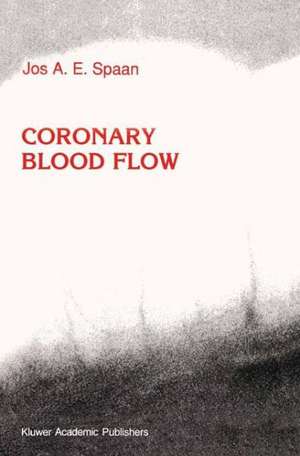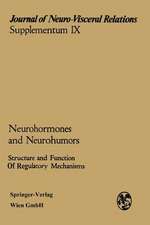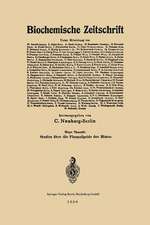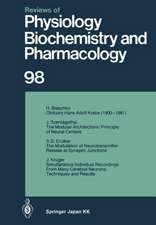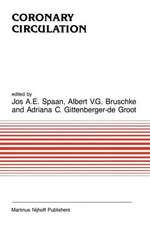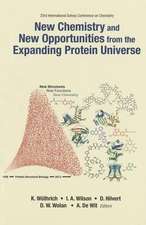Coronary Blood Flow: Mechanics, Distribution, and Control: Developments in Cardiovascular Medicine, cartea 124
Autor J.A. Spaanen Limba Engleză Hardback – 31 mai 1991
| Toate formatele și edițiile | Preț | Express |
|---|---|---|
| Paperback (1) | 1101.21 lei 6-8 săpt. | |
| SPRINGER NETHERLANDS – 25 sep 2012 | 1101.21 lei 6-8 săpt. | |
| Hardback (1) | 3185.49 lei 6-8 săpt. | |
| SPRINGER NETHERLANDS – 31 mai 1991 | 3185.49 lei 6-8 săpt. |
Din seria Developments in Cardiovascular Medicine
- 5%
 Preț: 1484.53 lei
Preț: 1484.53 lei - 5%
 Preț: 375.17 lei
Preț: 375.17 lei - 5%
 Preț: 354.10 lei
Preț: 354.10 lei - 5%
 Preț: 1419.03 lei
Preț: 1419.03 lei - 5%
 Preț: 376.43 lei
Preț: 376.43 lei - 5%
 Preț: 1098.27 lei
Preț: 1098.27 lei - 5%
 Preț: 1438.38 lei
Preț: 1438.38 lei - 5%
 Preț: 376.78 lei
Preț: 376.78 lei - 5%
 Preț: 368.37 lei
Preț: 368.37 lei - 5%
 Preț: 380.25 lei
Preț: 380.25 lei - 5%
 Preț: 2117.58 lei
Preț: 2117.58 lei - 5%
 Preț: 367.28 lei
Preț: 367.28 lei - 5%
 Preț: 366.56 lei
Preț: 366.56 lei - 5%
 Preț: 371.10 lei
Preț: 371.10 lei - 5%
 Preț: 370.94 lei
Preț: 370.94 lei - 5%
 Preț: 783.18 lei
Preț: 783.18 lei - 5%
 Preț: 713.18 lei
Preț: 713.18 lei - 5%
 Preț: 1098.27 lei
Preț: 1098.27 lei - 5%
 Preț: 375.49 lei
Preț: 375.49 lei - 5%
 Preț: 373.47 lei
Preț: 373.47 lei - 5%
 Preț: 723.93 lei
Preț: 723.93 lei - 5%
 Preț: 1104.13 lei
Preț: 1104.13 lei - 5%
 Preț: 2117.20 lei
Preț: 2117.20 lei - 5%
 Preț: 716.09 lei
Preț: 716.09 lei - 5%
 Preț: 372.03 lei
Preț: 372.03 lei - 5%
 Preț: 722.33 lei
Preț: 722.33 lei - 5%
 Preț: 660.07 lei
Preț: 660.07 lei - 5%
 Preț: 375.34 lei
Preț: 375.34 lei - 5%
 Preț: 1423.22 lei
Preț: 1423.22 lei - 5%
 Preț: 715.35 lei
Preț: 715.35 lei - 5%
 Preț: 790.69 lei
Preț: 790.69 lei - 5%
 Preț: 720.68 lei
Preț: 720.68 lei - 5%
 Preț: 1418.27 lei
Preț: 1418.27 lei - 5%
 Preț: 784.64 lei
Preț: 784.64 lei - 5%
 Preț: 714.63 lei
Preț: 714.63 lei - 5%
 Preț: 370.74 lei
Preț: 370.74 lei - 5%
 Preț: 376.22 lei
Preț: 376.22 lei - 5%
 Preț: 660.85 lei
Preț: 660.85 lei - 5%
 Preț: 368.37 lei
Preț: 368.37 lei
Preț: 3185.49 lei
Preț vechi: 3353.14 lei
-5% Nou
Puncte Express: 4778
Preț estimativ în valută:
609.56€ • 651.81$ • 508.23£
609.56€ • 651.81$ • 508.23£
Carte tipărită la comandă
Livrare economică 18 aprilie-02 mai
Preluare comenzi: 021 569.72.76
Specificații
ISBN-13: 9780792312109
ISBN-10: 0792312104
Pagini: 396
Ilustrații: XXIII, 396 p.
Dimensiuni: 155 x 235 x 28 mm
Greutate: 0.8 kg
Ediția:1991
Editura: SPRINGER NETHERLANDS
Colecția Springer
Seria Developments in Cardiovascular Medicine
Locul publicării:Dordrecht, Netherlands
ISBN-10: 0792312104
Pagini: 396
Ilustrații: XXIII, 396 p.
Dimensiuni: 155 x 235 x 28 mm
Greutate: 0.8 kg
Ediția:1991
Editura: SPRINGER NETHERLANDS
Colecția Springer
Seria Developments in Cardiovascular Medicine
Locul publicării:Dordrecht, Netherlands
Public țintă
ResearchCuprins
1 Basic coronary physiology.- 1.1 Introduction.- 1.1.1 Heart function and coronary flow.- 1.1.2 Control and extravascular resistance.- 1.1.3 Distribution of supply and demand.- 1.1.4 Mechanics, control and distribution in the coronary circulation.- 1.2 Coronary flow mechanics.- 1.2.1 Inhibition of coronary arterial flow during systole.- 1.2.2 Retrograde coronary arterial flow, venous flow and in-tramyocardial compliance.- 1.3 Regulation of coronary flow.- 1.3.1 Steady local control of coronary flow.- 1.3.2 How to define coronary tone?.- 1.3.3 Rate of adaptation of the coronary circulation to step changes in heart rate.- 1.3.4 Effect of perfusion pressure step.- 1.3.5 Reactive hyperemia.- 1.3.6 Mechanisms of coronary flow control.- 1.4 Heterogeneity in myocardial perfusion and oxygen supply.- 1.4.1 Distribution of flow from endocardium to epicardium.- 1.4.2 Heterogeneity induced by the arterial tree.- 1.4.3 Heterogeneity of oxygen supply/demand ratio.- 1.5 Relation between mechanics, control and distribution of coronary flow.- 1.6 Summary.- References.- 2 Structure and function of the coronary arterial tree.- 2.1 Basic anatomy.- 2.2 Collaterals.- 2.3 Structure of the coronary arterial tree.- 2.3.1 Ratios between diameters of mother and daughter branches.- 2.3.2 Growth of arterial cross-sectional area.- 2.3.3 Length distribution in the arterial tree.- 2.3.4 Arterial density applying symmetrical branching networks..- 2.4 Data on filling volume of the coronary arterial tree.- 2.5 Pressure distribution in the coronary arterial tree.- 2.6 Symmetrical, dichotomous branching network model.- 2.6.1 Definition of model structure.- 2.6.2 Prediction of volume.- 2.6.3 Prediction of pressure.- 2.7 Nonsymmetrical dichotomous branching network analysis.- 2.7.1 Strahler ordering.- 2.7.2Fractal models.- 2.8 Discussion on structure and function of the arterial tree.- 2.9 Summary.- References.- 3 Structure and perfusion of the capillary bed.- 3.1 Structure of capillary bed.- 3.2 Capillary density and volume.- 3.3 Mechanical properties.- 3.4 Red cells in the capillary bed.- 3.4.1 Velocities.- 3.4.2 Red cell distribution at bifurcations.- 3.4.3 Hematocrit.- 3.5 Model of parallel and homogeneous perfused capillary bed.- 3.6 A model for the heterogeneous perfusion of the capillary bed.- 3.7 Capillary recruitment in the heart.- 3.8 Summary.- References.- 4 Structure and function of coronary venous system.- 4.1 Basic anatomy.- 4.2 Distribution of coronary venous flow.- 4.3 Flow and pressure waves in the epicardial veins.- 4.4 Waterfall behavior of coronary epicardial veins.- 4.5 Coronary venous compliance.- 4.6 Summary.- References.- 5 Linear system analysis applied to the coronary circulation.- 5.1 Definitions.- 5.1.1 System.- 5.1.2 Linearity.- 5.1.3 Time and frequency domains.- 5.1.4 Models.- 5.1.5 Load line analysis.- 5.2 Linear intramyocardial pump model.- 5.2.1 Interpretation of the coronary load lines.- 5.2.2 Intramyocardial pump and the right coronary artery.- 5.2.3 Shortcomings of the linear intramyocardial pump model.- 5.3 Load line analysis of collateral flow.- 5.4 Input impedance.- 5.4.1 Input impedance during long diastoles.- 5.4.2 Coronary impulse response in diastole and systole.- 5.4.3 Model interpretation of coronary input impedance.- 5.5 Nonlinear physical elements and linear system analysis.- 5.6 Discussions of the linear models of coronary circulation.- 5.7 Summary.- References.- 6 Interaction between contraction and coronary flow: Theory.- 6.1 Systolic extravascular resistance model.- 6.1.1 Basic behavior of extravascular resistance model.-6.1.2 Discussion of extravascular resistance model.- 6.2 The waterfall model.- 6.2.1 Basic model behavior of the waterfall model.- 6.3 Nonlinear intramyocardial pump model.- 6.3.1 Pressure dependency of compartmental resistance.- 6.3.2 Steady state arterial pressure-flow relations during arrest.- 6.3.3 Solutions for the subendocardial model layer of the contracting myocardium.- 6.3.4 Compartmental volume variations.- 6.3.5 Flow simulations.- 6.4 Variable elastance model.- 6.4.1 Experimental support.- 6.4.2 Variable elastance concept.- 6.4.3 A mathematical intramyocardial pump model with time varying elastance as pump generator.- 6.5 Discussion.- 6.6 Summary.- References.- 7 Interaction between contraction and coronary flow: Experiment.- 7.1 Parallel shift of pressure-flow relations.- 7.2 Pressure dependency of coronary resistance.- 7.3 Effect of heart rate on microsphere distribution.- 7.4 Contractility and microsphere distribution.- 7.5 Intramyocardial compliance.- 7.6 Pulsations in coronary pressure at constant flow perfusion.- 7.7 Diastolic pressure-flow lines.- 7.8 Discussion.- 7.9 Summary.- References.- 8 Arteriolar mechanics and control of flow.- 8.1 Morphology of the arteriolar wall.- 8.2 Myogenic response.- 8.3 Arteriolar vasomotion.- 8.4 Strain and stress in the arteriolar wall.- 8.5 Myogenic responses in relation to autoregulation of flow.- 8.5.1 Relation between pressure and resistance with and without myogenic tone.- 8.5.2 Width of the autoregulatory plateau.- 8.5.3 The optimal strength of myogenic tone.- 8.6 Compliance of arterioles.- 8.6.1 Effect of tone on static compliance.- 8.6.2 Quasi-static distensibility of dilated coronary arteries.- 8.6.3 Frequency dependency of distensibility of active and passive small coronary arteries.- 8.7 Discussion.- 8.7.1Vasodilation.- 8.7.2 Arterioles and regulation of flow.- 8.8 Summary.- References.- 9 Static and dynamic analysis of local control of coronary flow.- 9.1 Introduction.- 9.2 Steady state behavior of flow control.- 9.3 Characteristics of dynamic coronary flow control.- 9.3.1 Rate of change in flow adaptation.- 9.3.2 Rate of change of autoregulation.- 9.3.3 Summary of t50 values.- 9.4 Rate of change in myocardial oxygen Consumption.- 9.4.1 Model for the correction of changing oxygen buffers.- 9.4.2 Transients in oxygen consumption.- 9.5 Oxygen model of coronary flow control.- 9.5.1 Model definition and equations.- 9.5.2 Steady state solutions.- 9.5.3 Dynamic solutions of the oxygen model.- 9.5.4 Oxygen dose-response curves.- 9.6 Myocardial contraction and dynamics of coronary flow control.- 9.7 The directional effect in dynamic responses of autoregulation.- 9.8 Myogenic response in the coronary circulation.- 9.9 Adenosine model.- 9.9.1 Adenosine dose-response curves.- 9.9.2 Experimental evidence for and against the adenosine hypothesis.- 9.10 Discussion.- 9.10.1 Adaptation of coronary flow in animals and humans.- 9.10.2 Evaluation of pharmacological coronary vasodilators.- 9.10.3 Flow adaptation and oxygen extraction.- 9.10.4 Integration of different possible mechanisms for controlling coronary flow.- 9.10.5 The use of models on flow control.- 9.11 Summary.- References.- 10 Water balance within the myocardium.- 10.1 Introduction.- 10.2 Myocardial interstitium and lymph.- 10.3 Transport of water and proteins across the capillary membrane.- 10.3.1 Routes.- 10.3.2 Driving forces.- 10.3.3 Lymph flow and protein concentration.- 10.4 Dynamic changes in interstitial volume and pressure.- 10.4.1 Heart weight and vascular volume experiments.- 10.4.2 Lymphatic pressure.- 10.5 Numbers on permeability, surface area and reflection coefficients.- 10.6 Compliance of the interstitial space.- 10.7 Transcapillary water transport and cardiac contraction.- 10.7.1 Waterfall model and linear intramyocardial pump model: effect of coronary arterial pressure.- 10.7.2 Nonlinear intramyocardial pump model: the effect of arterial pressure.- 10.7.3 Simulated transmural pressure as function of heart rate at constant arterial pressure.- 10.8 Discussion.- 10.8.1 Transmural differences in water balance.- 10.8.2 Stabilizing mechanisms in transmural capillary pressure.- 10.8.3 Tissue pressure versus time varying elastance and water balance.- 10.9 Summary.- References.- 11 Oxygen exchange between blood and tissue in the myocardium.- 11.1 Introduction.- 11.2 Experimental data on oxygen distribution in the myocardium.- 11.3 Oxygen transfer from a single capillary without intercapillary exchange.- 11.3.1 Krogh solution.- 11.3.2 Maximal radius of the Krogh cylinder.- 11.3.3 General solution to the Krogh problem.- 11.3.4 Decrease of oxygen partial pressure in a perfused capillary applying the Krogh model.- 11.4 Capillary interaction with blood-tissue oxygen exchange.- 11.4.1 Oxygen pressure distribution.- 11.4.2 Average oxygen pressures in tissue units and oxygen flow through these.- 11.4.3 Tissue oxygen distribution in a network model inducing heterogeneous capillary flow.- 11.4.4 Oxygen histograms.- 11.4.5 Oxygen pressure history of a red cell travelling through the capillary network.- 11.5 Oxygen diffusion from the ventricular cavity and thoracic space.- 11.6 Effect of oxygen consumption localized in the mitochondria.- 11.6.1 Equations.- 11.6.2 Effect of mitochondrial oxygen consumption on oxygen pressure distribution.- 11.6.3 Oxygen pressure near mitochondria.- 11.7 Intracellular oxygen transfer and resistance of the capillary wall to oxygen.- 11.7.1 Diffusion coefficient of oxygen in tissue.- 11.7.2 Facilitation of oxygen by myoglobin.- 11.7.3 Diffusion resistance of the capillary wall.- 11.7.4 Myoglobin as an oxygen store.- 11.8 Summary.- References.- 12 Limitation of coronary flow reserve by a stenosis.- 12.1 Introduction.- 12.2 Coronary flow reserve.- 12.3 Coronary stenosis and flow reserve.- 12.4 Prediction of pressure drop over a coronary stenosis.- 12.4.1 Pressure drop by viscous losses.- 12.4.2 Pressure loss by convective acceleration.- 12.4.3 Dependence of pressure drop over stenosis on stenosis diameter.- 12.5 Absolute versus relative definition of a stenosis.- 12.6 Effect of stenosis geometry and flow pulsatility on pressure drop.- 12.7 Theoretical optimization of coronary reserve.- 12.7.1 Effect of heart rate.- 12.7.2 Reserve and flow ratio in the presence of a stenosis.- 12.7.3 Hemodilution in the presence of a stenosis.- 12.8 Reflections on the clinical use of coronary flow reserve.- 12.9 Summary.- References.- A Equivalent schematic for calculation of pressure distribution.- B Nonlinear pump model.- References.- C Calculation of oxygen consumption with changing flow.- References.- D The Krogh model.- D.1 Definition of the problem.- D.2 Simplified equation for maximal Krogh radius.- D.3 Derivations of the Krogh model.- Author Index.
Recenzii
'In Summary, this is an excellent compendium of the current state of our knowledge on coronary haemodynamics and I recommend it to anyone who works with the perfused heart.' Cardiovascular Research 1992
